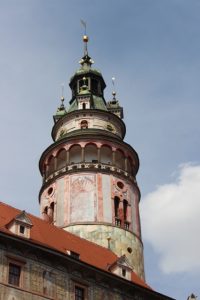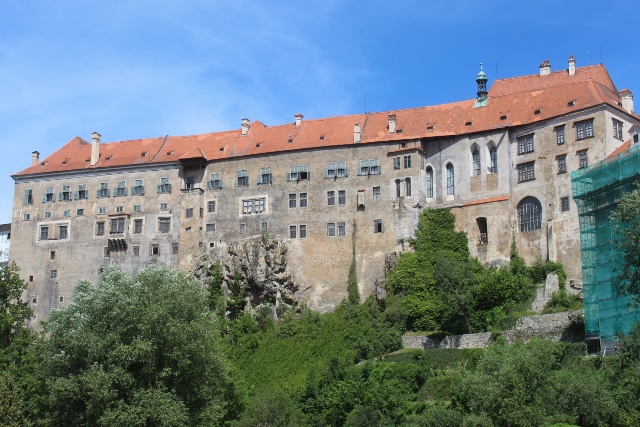Cesky Krumlov is indeed one of the nicest medieval towns in the country, but can, at least in July, only be viewed together with lots of other tourists.
Billed as the most charming Medieval town of the Czech Republic, Cesky Krumlov is also – outside Prague, perhaps – the most touristic town in the country. True to form, another big castle cum palace dominates the town, in the form of a huge multi-floor grey stone block and a wedding cake-like round tower, whilst on both sides of the Vltava river lovely pastel coloured houses line the streets and several squares. Some of the houses are decorated with the by now well-known sgraffito technique, others have elaborate frescoes on their facades and gables. Cobbled streets lead to an enormous church, the Saint Vitus church, that towers high above the red-tiled roofs, or to a cluster of monasteries.
And then there are the tourists, although probably not as much as in a normal July month. They are mostly Czech, we only saw two or three touring-car derived tourists groups – German, I think – the rest was individual people. Who come with dogs, with prams – and small children inside, or just slightly older children who refuse to get back in the prams -, with their old-age parents, or with their bicycles. And yet, all very well behaved; no barking – the dogs – and no screaming – the children. And all moves quite relaxed through the narrow streets, up to the castle, into the palace gardens, on the terraces. And into the plastic inflatable boats and canoes that populate the river around town: the thing to do is to rent one of those and float or paddle downstream, passing below the several bridges in the process. Perhaps a superfluous comment: we didn’t.
But we did walk up to the castle, passed through all five courtyards (failed to find the entry for the tower, though), and met the downside of the lack of international tourism: as in so many other places in the Czech Republic, you can only visit inside with a guided tour, but without foreigners, those are almost exclusively in Czech, not our strongest language yet. So we skipped the Rococo ball rooms and the Baroque living quarters and all the other frescoed and stuccoed rooms inside the castle; in any case, the outside of the castle was also richly decorated and it was a far too beautiful day to spend inside, with a slow-moving group of tourist listening to a language we didn’t understand.
At the far end of the castle are the gardens, a fabulous collection of tightly trimmed hedges and flowery fields, very well maintained. With a great view over town, too.
Back in the main part of town, we wander the streets, the squares, and make an attempt to find the Egon Schiele centre. Schiele , whose mother came from here, lived in one of the small houses along the river. At the time, he was not very popular with the locals, because of his paintings of naked models, but now Cesky Krumlov has adopted Schiele as a lost son. Except that the Egon Schiele centre, which we finally located, is closed.
Outside town is the Blansky les, a wooded nature area that, literally, culminates in Mount Klet, with 1083 m the highest peak in the surroundings. The good thing is that there is a chairlift that goes up to the summit, from where, from an old, round observatory tower built in 1832, you have a fabulous 360o view across the plains, inside the Czech Republic, but also into Austria. Of course, you can also walk up, which is what many of the locals do, taking their small children, and in one case even pushing a pram uphill!
The way down is easier, and well signposted – as so many other tracks are in the touristic areas of this country.
next: the towns of Trebon and Pelrhimov.













































